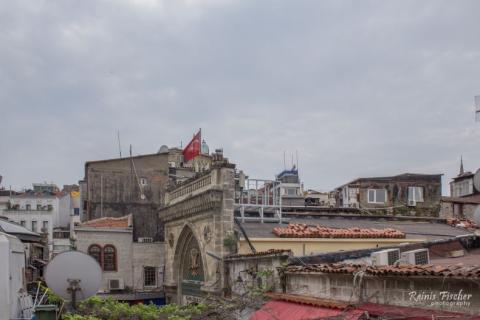The Grand Bazaar in Istanbul is one of the largest and oldest covered markets in the world, with 61 covered streets and over 4,000 shops which attract between 250,000 and 400,000 visitors daily.
In 2014, it was listed No.1 among world's most-visited tourist attractions with 91,250,000 annual visitors. The Grand Bazar at Istanbul is often regarded as one of the first shopping malls of the world.
During my latest trip to Istanbul, which was actually a layover flight connecting to Tbilisi, I stayed for a one noght in Sultan Ahmet district and decided to photograph some cool sites in Istanbul, unfortunately during my trip to the Grand Bazaar in early morning hour it was still closed, so all I could get - just closed gates. On the other hand I've been to this market several times already, and trust me, if you haven't been here, it' s a must have while in Istanbul.

Rooftops of the Grand Bazaar in Istanbul
The Grand Bazaar is located inside the Walled city of Istanbul, in the district of Fatih and in the neighbourhood (mahalle) bearing the same name (Kapalıçarşı). It stretches roughly from west to east between the mosques of Beyazit and of Nuruosmaniye. The Bazaar can easily be reached from Sultanahmet and Sirkeci by trams (Beyazıt-Kapalıçarşı stop).

Gates at Grand Bazaar
Today the Grand Bazaar is a thriving complex, employing 26,000 people visited by between 250,000 and 400,000 visitors daily, and one of the major landmarks of Istanbul. It must compete with modern shopping malls common in Istanbul, but its beauty and fascination represent a formidable advantage for it. The head of the Grand Bazaar Artisans Association claimed that the complex was in 2011 – the year of its 550th birthday – the most visited monument in the world.
A restoration project starting in 2012 should renew its infrastructure, heating and lighting systems. Moreover, the hans inside the Market will be renovated and later additions will be demolished. This project should finally solve the big problems of the market: for example, in the whole Bazaar there is no proper toilet facility. Moreover, the lacks of controls in the past years allowed many dealers to remove columns and skive walls in their shops to gain space: This, together with the substitution of lead (stolen in the last years) with concrete on the market's roof, has created a great hazard when the earthquake expected in Istanbul in the next years will occur.
The Grand Bazaar is opened each day except Sundays and bank holidays from 9:00 until 19:00.
As stated above, we tried to visit it in an early morning hour, when it was still closed.

Nearby streets at Grand Bazaar Istanbul
The construction of the future Grand Bazaar's core started during the winter of 1455/56, shortly after the Ottoman conquest of Constantinople and was part of a broader initiative to stimulate economic prosperity in Istanbul. Sultan Mehmet II had an edifice erected devoted to the trading of textiles. It was named Cevâhir Bedestan (‘Bedesten of Gems’) and was also known as Bezzâzistan-ı Cedîd (‘New Bedesten’) in Ottoman Turkish. The word bedesten is adapted from the Persian word bezestan, derived from bez ("cloth"), and means "bazaar of the cloth sellers" The building – named alternately in Turkish İç (‘Internal’), Atik (‘Ancient’), or Eski (‘Old’) Bedesten – lies on the slope of the third hill of Istanbul, between the ancient Fora of Constantine and of Theodosius. It was also near the first sultan's palace, the Old Palace (Eski Sarayi), which was also in construction in those same years, and not far from the Artopoleia (in Greek) (Άρτοπωλεία), the city's bakers' quarter in Byzantine times.





